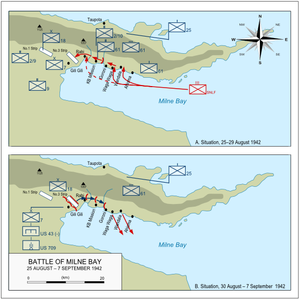
In late August 1942, a little-known bay at the eastern tip of New Guinea erupted into a fierce battle that would mark a turning point in the Pacific War. The remote Milne Bay became the stage for a decisive Allied victory, orchestrated from the unlikely command center of Brisbane, Australia, and bolstered by the crucial participation of the Netherlands merchant fleet.
Securing a Strategic Airbase
With Japanese forces advancing rapidly through Papua New Guinea, the Allies recognized the urgent need to establish airfields at Milne Bay. These airfields would provide vital support for the defence of Port Moresby and offer a springboard for counteroffensives. However, the Japanese also grasped Milne Bay’s strategic importance, launching their own invasion plan.
Brisbane: The Planning Hub
General Douglas MacArthur’s headquarters in Brisbane transformed into a whirlwind of strategic planning. Intelligence reports detailed the expected Japanese invasion force, allowing Allied commanders to tailor their defences. Crucially, the Netherlands merchant fleet, operating under Allied command, played a vital role. Known as the KPM ships, these resilient vessels were tasked with transporting Australian troops and supplies to strengthen Milne Bay’s defences.
The KPM Ships: Lifeline of Milne Bay
The Royal Packet Navigation Company (Koninklijke Paketvaart-Maatschappij -KPM) ships were pressed into Allied service after the Japanese invasion of the Dutch East Indies and proved invaluable for logistical operations throughout the Southwest Pacific. They played a vital role in transporting troops and supplies to Milne Bay in the lead-up to the battle, it’s important to clarify that they were not directly involved in the combat itself. They braved treacherous waters, facing relentless attacks from Japanese aircraft. Their unwavering commitment, despite heavy losses, proved indispensable. Brisbane became the coordination hub for these resupply missions, ensuring a steady flow of reinforcements and materiel to the embattled troops ashore.
See also: Dutch participation in Battle of Milne Bay 1942
Japanese Defeated
The Japanese, underestimating Allied strength and resolve, landed at Milne Bay on August 25th, 1942. What followed was nearly two weeks of brutal combat. Australian infantry, supported by American artillery and engineers, fought ferociously, aided by the Kittyhawk fighters operating from the hastily built airfields. The Japanese, outmaneuvered and outgunned, suffered a crushing defeat – their first major land setback of the war.
Brisbane’s Triumph
The Battle of Milne Bay stands as a testament to the strategic brilliance forged in Brisbane and the bravery of those who fought on the ground. It highlighted the importance of integrated Allied forces and underscored the crucial role played by cities behind the front lines. The Dutch KPM ships, often overlooked in historical accounts, were an essential component in delivering victory, their sacrifices embodying the multinational effort required to halt the Japanese advance.
The palm-fringed beaches and jungles of Milne Bay may seem a world away from the bustling streets of Brisbane. Yet, it was from this Australian city that the blueprint for a crucial Allied victory was drawn, marking a pivotal step towards the long road to liberation in the Pacific.
See alos:
